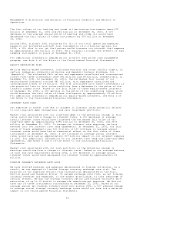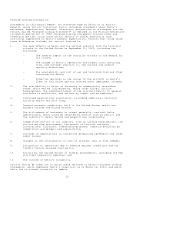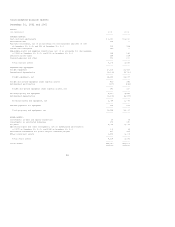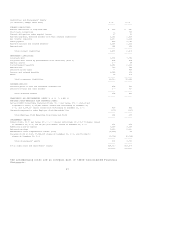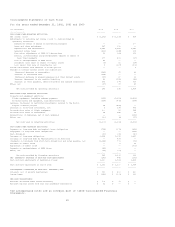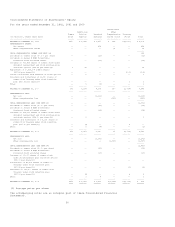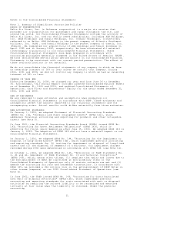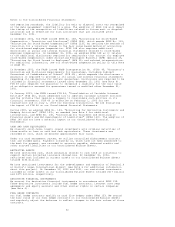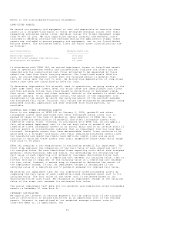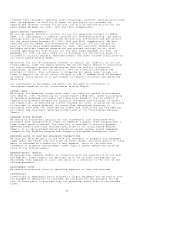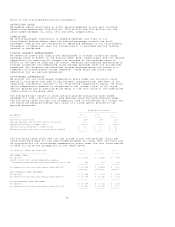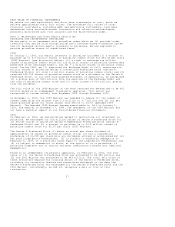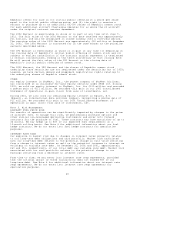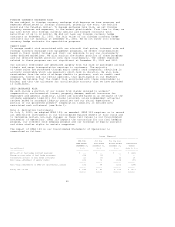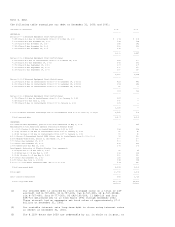Delta Airlines 2002 Annual Report Download - page 139
Download and view the complete annual report
Please find page 139 of the 2002 Delta Airlines annual report below. You can navigate through the pages in the report by either clicking on the pages listed below, or by using the keyword search tool below to find specific information within the annual report.Notes to the Consolidated Financial Statements
LONG-LIVED ASSETS
We record our property and equipment at cost and depreciate or amortize these
assets on a straight-line basis to their estimated residual values over their
respective estimated useful lives. Residual values for flight equipment range
from 5%-40% of cost. We also capitalize certain internal and external costs
incurred to develop internal-use software during the application stage; these
assets are included in ground property and equipment, net on our Consolidated
Balance Sheets. The estimated useful lives for major asset classifications are
as follows:
Asset Classification Estimated Useful Life
-------------------- ---------------------
Owned flight equipment 15-25 years
Flight and ground equipment under capital lease Lease Term
Ground property and equipment 3-30 years
In accordance with SFAS 144, we record impairment losses on long-lived assets
used in operations when events and circumstances indicate the assets may be
impaired and the undiscounted cash flows estimated to be generated by those
assets are less than their carrying amounts. For long-lived assets held for
sale, we record impairment losses when the carrying amount is greater than
the fair value less the cost to sell. We discontinue depreciation of long-lived
assets once they are classified as held for sale.
To determine impairments for aircraft used in operations, we group assets at the
fleet type level (the lowest level for which there are identifiable cash flows)
and then estimate future cash flows based on projections of passenger yield,
fuel costs, labor costs and other relevant factors in the markets in which these
aircraft operate. If an impairment occurs, the amount of the impairment loss
recognized is the amount by which the carrying amount of the aircraft exceeds
the estimated fair value. Aircraft fair values are estimated by management using
published sources, appraisals and bids received from third parties, as
available.
GOODWILL AND OTHER INTANGIBLE ASSETS
Prior to our adoption of SFAS 142 on January 1, 2002, goodwill and other
intangible assets were amortized over their estimated useful lives (not to
exceed 40 years in the case of goodwill). Upon adoption of SFAS 142, we
discontinued the amortization of goodwill and other intangible assets with
indefinite useful lives. Instead, in accordance with SFAS 142, we now apply a
fair value-based impairment test to the net book value of goodwill and
indefinite-lived intangible assets on an annual basis and on an interim basis if
certain events or circumstances indicate that an impairment loss may have been
incurred. Intangible assets that have determinable useful lives continue to be
amortized on a straight-line basis over their remaining estimated useful lives.
Our leasehold and operating rights have definite useful lives and we will
continue to amortize these assets over their respective lease terms which range
from nine to 19 years.
SFAS 142 requires a two-step process in evaluating goodwill for impairment. The
first step requires the comparison of the fair value of each reporting unit to
its carrying value. We have identified three reporting units which have assigned
goodwill: Delta-mainline, ASA and Comair. Our methodology for estimating the
fair value of each reporting unit primarily considers discounted future cash
flows. If the fair value of a reporting unit exceeds its carrying value, then no
further testing is required. If the carrying value of a reporting unit exceeds
its fair value, however, a second step is required to determine the amount of
the impairment charge, if any. An impairment charge is recognized if the
carrying value of a reporting unit's goodwill exceeds its implied fair value.
We perform our impairment test for our indefinite-lived intangible assets by
comparing the fair value of each indefinite-lived intangible asset unit to its
carrying value. The fair value of the asset unit is estimated based on its
discounted future cash flows. We recognize an impairment charge if the carrying
value of the asset unit exceeds its estimated fair value.
The annual impairment test date for our goodwill and indefinite-lived intangible
assets is December 31 (see Note 5).
INTEREST CAPITALIZED
We capitalize interest on advance payments for the acquisition of new aircraft
and on construction of ground facilities as an additional cost of the related
assets. Interest is capitalized at our weighted average interest rate on
long-term debt or, if applicable, the
34


